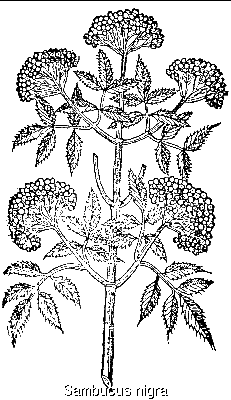ELDER
(Sambucus nigra)

Appearance
A shrubby deciduous tree with fragrant, divided
leaves. White, hermaphrodite flowers in flat topped masses appear between
April and July. Fruit is a berry-like droupe, purplish-black when ripe.
Habitat
Found commonly all over Cyprus both on cultivated and waste
ground. It is commonly cultivated in towns and villages and is
almost certainly an introduced plant. Occurs from sea-level to 4,000 ft.
Uses and Properties
The plant is a traditional source of various dyes, black
dye from the bark and roots, green dye from the leaves and various
violet dyes from the berries. Elder wine, syrup and cordial are made
from the flowers and berries. Widely used in traditional and modern
medicine. The bark contains the purgative sambucine, the flowers
fragrant oil, the fruits tannin, muselage, potassium nitrate and vitamin C.
An infusion from elder flowers known as "Tsai zambucos" is taken to
combat colds, fevers, pharyngitis, tonsilitis, nephritis and stomatitis in
Cyprus. Traditionally bark and root extracts were used as laxatives and
leaf extracts as ointment for bruises. Elder flower water used in eye and
skin lotions. In modern medicine the flowers are employed for their
strong diaphoritic action against fevers and also as diurectics and
expectorants. It is often taken as a hot infusion to increase the
sweating effect. The wood is highly resistant and holy crosses amongst
other things are made from it, partly because it is believed that Judas hung
himself from an elder tree.




